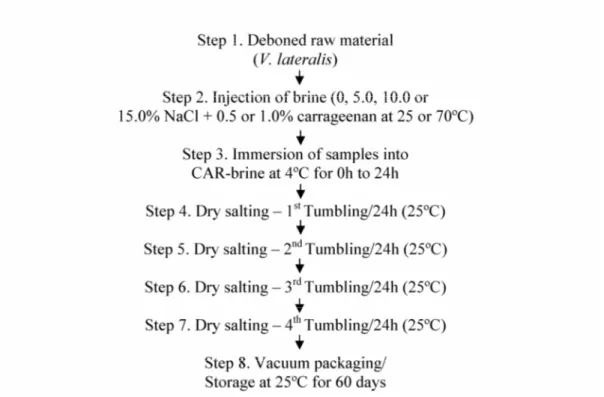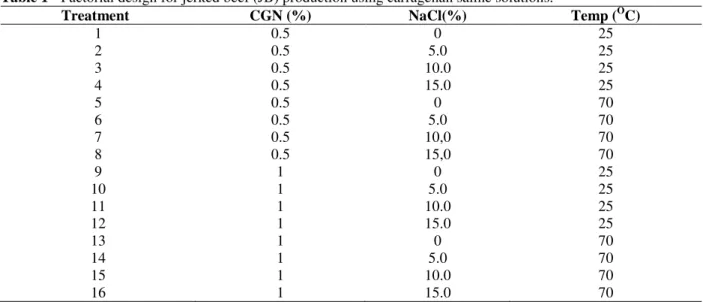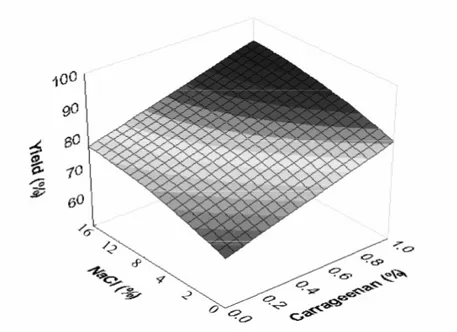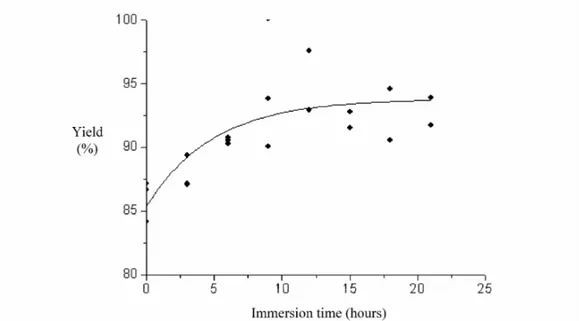Vol.56, n.2: pp. 311-318, March-April 2013
ISSN 1516-8913 Printed in Brazil BRAZILIAN ARCHIVES OF
BIOLOGY AND TECHNOLOGY
A N I N T E R N A T I O N A L J O U R N A L
Effect of Carrageenan Addition on the Yield and Functional
Properties of Charqui (Jerked Beef)
Carlos Eduardo Rocha Garcia
1,2, FabioYamashita
1, Elza Youssef Youssef
1, Sandra Helena
Prudencio
1and Massami Shimokomaki
1,3*1Departamento de Ciência e Tecnologia dos Alimentos; Universidade Estadual de Londrina; C.P.:6001;
86051-900; Londrina – PR - Brasil. 2 Departamento de Farmácia; Universidade Federal do Paraná; 80210-170, Curitiba – PR - Brasil. 3 Departamento de Pesquisa e Pós-Graduação; Universidadde Tecnológica Federal do Paraná; Av dos Pioneiros, 3131; 86036-6130; Londrina – PR - Brasil
ABSTRACT
The objective of this work was to evaluate the application of carrageenan (CAR) to improve the functional properties of the jerked beef (JF) and to increase its processing yield. JB produced from Vastus lateralis with CAR (1.0%) at 25ºC and NaCl (15.0%) had approximately 15.0% higher moisture and a 32.0% higher processing yield in comparison to the control samples. JB-CAR presented shear force approximately 5.0 and 20% lower in the samples uncooked salted and desalted cooked, respectively, and sensorial acceptance above 80%. The results demonstrated the possibility of applying carrageenan to jerked beef in order to obtain an increase in the processing yield and a tender product while maintaining the sensorial quality and its intermediate-moisture meat product nature.
Key words: additives, hydrocolloids, meat products, texture
*Author for correspondence: mshimo@uel.br
INTRODUCTION
Charqui meat (CM) is a typical Brazilian meat product, processed by the traditional techniques by applying the salt and drying in the sun. This technology eliminates the need to use refrigeration in order to preserve it microbiologically. Although CM processing is still based on an old practice, this technique follows the current principles of a food processing technology, known as hurdle technology, put forward by Leistner and Gorris (1995). After the salting and drying steps, the final
product has a water activity (aw) of 0.70-0.75,
classifying it as an intermediate-moisture meat product (Shimokomaki et al. 1998). The observed water activity is the result of chemical reaction equilibrium among the NaCl, protein, and
moisture available within the meat system (Shimokomaki et al. 1998). New technological advances that have been introduced, such as the addition of cured salt and vacuum packaging, create additional hurdles which microorganisms are unable to overcome, thus providing increasing food safety. The product processed with these additional hurdles is commercially known as jerked beef (JB) (Lara et al. 2003). The Brazilian Agricultural Ministry has established legal regulations for the chemical composition of commercial JB: maximum moisture of 55.0%,
18.3% ash, 50 ppm of sodium nitrite, maximum aw
value of 0.78, and application of vacuum packaging (Brasil 2000). In a work to demonstrate
the fermented nature of the product; S. carnosus
Garcia, C. E. R. et al. 312
starter culture (Pinto et al. 2002). Despite all the qualities described above, JB has been shown not to be a tender meat product. Charqui meat texture is affected by a multitude of factors, in particular by the dynamic process of myofibril proteins promoting the biochemical events such as the binding of water molecules. The amount of bound water ultimately or rather the higher concentration of myofibrils proteins, dictates the final charqui meat texture (Youssef et al. 2007).
Hydrocolloids such as carrageenan (CAR) are primarily used to enhance the functional properties of foods. CAR has the ability to form aqueous dispersions, and also to retain water. It is applied as a food thicker and stabilizer and has successfully been used as a fat substitute (Keeton 1994). CAR is a polysaccharide, composed of sulfated polymers of galactose and anhydride
galactose, extracted from the red algae.
Commercially available CAR consists of three main fractions: kappa, iota, and lambda, and only the last fraction is not capable of forming a gel (Giese 1992). The objective of this work was to evaluate the application of carrageenan to JB in order to improve its functional properties by retaining the water intramuscularly, thus making the product less tougher and increasing the JB processing yield.
MATERIALS AND METHODS
Samples preparation
For each treatment, Vastus lateralis m beef
samples in triplicate were cut into cubes of approximately 50 x 50 x 50 mm, totalizing one hundred grams each and kept at 4ºC (±1ºC). The CAR was prepared with 50.0% kappa and 50% iota fractions of food grade quality (Globalfood, São Paulo, Brazil).
Jerked beef processing
Figure 1 shows the step-by-step fluxogram of JB processing with the CAR (JB-CAR). The CAR (0.5 or 1.0%) was diluted in brine heated at two temperatures (25 or 70ºC). The brine NaCl concentrations (CAR-brine) were 0.0, 5.0, 10.0, and 15.0%. It was injected manually into 60% (v/w) in relation to the fresh meat samples. Sodium nitrite was also dissolved in brine in
concentrations of 50 ppm. The injected meat samples were subsequently kept immersed in excess of CAR-brine injected for 0 to 24 h at 4ºC (±1ºC). Finally, the meat samples were submitted to dry salting as described by Shimokomaki et al. (1998) and samples were kept at 25ºC with daily changes of rock salt for four days. Excess salt was removed manually from the meat surface and it was then stored at 25ºC in vacuum packaging for up to 60 days.
Effect of CAR, NaCl concentrations and brine temperatures on JB processing yield
The samples of JB-CAR were prepared according
to the factorial design ANOVA (2 x 2 x 4) by
varying the temperature values (25 and 70ºC) of the CAR-brine, CAR concentrations (0.5 and 1.0% in relation to the raw material weight), and brine NaCl concentration (0.0, 5.0, 10.0 and 15.0%).
Effect of CAR-brine immersion time on JB processing yield
The fresh meat time lengths of immersion in the CAR-brine solution necessary to obtain the best processing yield were investigated in the products according to the fluxogram described in Figure 1. This immersion time varied from 0 to 24h. In this experiment, the CAR-brine was injected only at 25ºC. At every 2 h, triplicate JB samples were collected and submitted for salting (steps 3 to 7, Fig. 1), before the yield calculations were performed.
Chemical composition, aw and JB-CAR
processing yield
The samples resulting from the highest processing yield were evaluated in relation to the proximate
chemical composition and aw. Moisture, ash,
Figure 1 – Fluxogram showing step-by-step jerked beef processing injected with carrageenan in brine solution (based in Shimokomaki et al. 1998).
Texture measurement
The evaluation of shear value was carried out for the highest processing yield of the JB-CAR samples having as control CAR-free samples. This measurement was performed in uncooked salted and desalted cooked samples. The latter samples were obtained under the copiously treatment with distilled water. Then the meat pieces were packed in the propylene bags under the vacuum and subsequently cooked in a water bath until the internal temperature reached 75ºC, as measured by a Hanna thermocouple, model HI 8313 (USA). The samples were cooled down to room temperature and the meat surface was dried with absorbent paper (Youssef et al. 2007). Meat texture was measured by Warner-Bratzler shear force, using a SMS Texture Analyzer, TAXT2i model (England), linked to a microcomputer
(Youssef et al. 2007). All the measurements were
carried out on 10 samples in triplicate.
Sensory analysis
The samples resulting from the highest processing yield were desalted and cooked in water bath to an
internal temperature of 75-78ºC, under
approximately 15 x 10 x 10 mm size, cooled down
to 40oC and submitted to a randomly selected taste
panel composed of 35 panelists, familiar to the charqui products and untrained tasters. They were 12 males and 23 females of different ages. The microbiological quality of the samples was monitored following the standard methodologies according to the Brazilian legislation (Brasil 2001). Each sensory analysis was performed in an individual booth under white light where meat samples were arranged on polyethylene plate. The panelists were asked to indicate a value on a structured 9-point hedonic scale (from 1 = dislike very much to 9 = like very much) (Stone and Sidel, 1993).
Total microbial counts
Total aerobic colony counts were determined in order to observe the effect of processing and storage on the JB-CAR microbiological safety. The samples obtained from the higher processing yield were examined after 0, 4, 30, and 60 days of storage at 25ºC by the pour plate method using the standard plate count agar incubated at 37ºC for 48
h (Pinto et al. 2002, Rocha-Garcia et al. 2003).
Garcia, C. E. R. et al. 314
per gram and represented the average of three counts.
Statistical analysis
Results were evaluated with Statistics for Windows 5.0 (Statsoft 1995) for the analysis of variance, multiple linear regression, Tukey’s and Student's t-tests. The experimental responses for
the processing yield from the factorial 2 x 4 x 2 (Table 1) design were planned and analyzed with the Experimental Design of Statistica Program 5.0 (Statsoft 1995) and the model obtained was correlated to the responses of the independent variables (concentration of CAR, NaCl and brine temperature). The program generated the response surface figures from the adjusted models.
Table 1 - Factorial design for jerked beef (JB) production using carragenan saline solutions.
Treatment CGN (%) NaCl(%) Temp (OC)
1 0.5 0 25
2 0.5 5.0 25
3 0.5 10.0 25
4 0.5 15.0 25
5 0.5 0 70
6 0.5 5.0 70
7 0.5 10,0 70
8 0.5 15,0 70
9 1 0 25
10 1 5.0 25
11 1 10.0 25
12 1 15.0 25
13 1 0 70
14 1 5.0 70
15 1 10.0 70
16 1 15.0 70
RESULTS AND DISCUSSION
Effect of CAR concentration and brine temperature on JB processing yield
The JB was produced in higher yields in proportion to the increase of the CAR concentrations, irrespective of the temperature of CAR-brine injected into the fresh meat (Fig. 2). The CAR has a strong interaction with water because it is able to form ionic linkages through the relatively high number of hydroxyl groups negatively charged on their ester sulfate groups (Labuza and Busk 1979). When the CAR (fractions kappa and iota) was heated to approximately 70 and 58ºC, respectively, and then allowed to cool down to ambient temperature, the formed gel retained water in its molecular structure, giving rise to the increase in the
processing yield of meat products (Bater et al.
1993), although the use of cold CAR solution reported in other works demonstrated its
water-holding capacity (Defreitas et al. 1997).
Increasing concentrations of the CAR and NaCl injected into the fresh meat increased the JB processing yield (Fig.3). Results indicated that
there were positive interactions between the injected CAR and NaCl, thus the processing yield. Injected CAR concentrations of approximately 1.0% dissolved in 15.0% brine drastically reduced the weight losses during the processing steps, maintaining the JB mass near 100% of its original raw material value.
Other reports have stated that the CAR capacity to hold the water within a meat product is influenced by the ions present at the meat matrix milieu (Bernal et al. 1987). The solubility properties of myofibril proteins in saline solution, particularly myosin and actin, influence the water holding capacity and subsequently the processing yield and texture of meat products (Smith 1988). Lower salt concentrations increase the myofibril proteins solubility, depending on the temperature and pH of
the solution originating the salting in phenomena
Figure 2 – Processing yield of jerked beef production to carrageenan concentration and temperature at 7.5% NaCl in brine.
Figure 3 – Processing yield of jerked beef production in relation to NaCl and carrageenan
concentration in brine.
Effect of CAR-brine immersion time of raw material on JB processing yield
Figure 4 shows the increase of processing yield according to the contact time between the raw material and the injected CAR-brine. The
equilibrium among the protein, NaCl,
hydrocolloids and water was reached after
Garcia, C. E. R. et al. 316
Figure 4 – Jerked beef processing yield versus immersion time in CAR-brine at 25ºC (NaCl 15.0% +
CAR 1.0%).
Processing yield and chemical composition of jerked beef processed with carrageenan
Table 2 shows the proximate chemical
composition of samples of the JB injected with 1.0% carrageenan, dissolved in 15% brine at 25ºC, and kept immersed at 4ºC (±1ºC) for 12h. Salting caused a reduction of pH and it was not influenced by the carrageenan. The JB-CAR sample contained approximately 15% more moisture and ash than the control; however, the higher saline concentration reached higher NaCl concentration (19.77%), as allowed by the JB legislation (18.3%) and its use substantially reduced the processing loss, keeping the raw meat and JB at similar quantitative mass levels, while the control samples showed a loss of approximately 25% in weight.
The use of the CAR resulted in the JB yield approximately 32% higher than the control. With the increase of water and ash, proportionally there was a decrease in the protein and lipid fraction of approximately 25 and 10%, respectively in the JB samples.
These results were in agreement to those reported
by Egbertet al. (1991) for the hamburgers injected
with 0.5% CAR and 10% water, increasing their moisture by 15% in relation to the raw material. This particular functional property of water retention capacity by the CAR in meat products has been described as a fat substitute in the production of low-fat meat products (Candogan and Kolsarici 2003; Keeton 1994).
Table 2 - Processing yield and chemical composition of Jerked beef (JB) injected with NaCl (15.0%) and 1%
carrageenan (CAR).
Raw material (%) JB (%) Jerked beef + CAR (%)
Yield 100.0 72.96b (±2) 96.93a (±3.04)
pH 5.97a 5.90b 5.90b
Moisture 74.04a (±0.07) 48.99c (±0.62) 54.83b (±0.49)
Ash 0.95c (±0.06) 17.91b (±0.45) 19.77a (±0.54)
Protein 21.75b (±0.47) 28.49a (±1.28) 21.2b (±1.01)
Lipid 2.9a (±0.53) 4.55a (±1.06) 4.05a (±0.47)
( ) Standard deviation
a,b
Monitoring water activity, moisture, and ash values throughout Jerked beef processing
The values for the moisture, water activity, and ash in the JB-CAR (injected with 15% NaCl+ 1.0% CGN/25ºC) reached a stable value after the third day of dry salting (Table 3). Similar results were observed previously for the JB without CAR (Youssef et al. 2007; Torres et al. 1994). In charqui meat, the consequence of equilibrium
established among the three components,
salt:protein:water, was the final constant value of
aw of approximately 0.75, regardless of whether
more salting or processing time was added
(Shimokomaki et al. 1998). A similar result was
observed when the CAR was added, although more water molecules were introduced in the meat system. In order to follow the equilibrium within these components, the water molecules must chemically be associated to the CAR.
Although there were higher moisture values in
JB-CAR product, the aw value was constant at 0.76,
classifying this product as an intermediate-moisture meat product. Along with NaCl, sodium
nitrite, and temperature, aw is another hurdle for
the growth of pathogenic microorganisms in JB
(Shimokomaki et al. 1998).
Table 3 - Water activity (aw), moisture and ash determination step by step throughout berked beef processing with
1.0% carrageenan (CAR).
Processing steps Time (h) aw Moisture (%) Ash (%)
Raw material 0 0.99 (±0.01) 76.4 (±0.1) 1.1 (±0.1)
CAR-brine injection 0 0.97 (±0.01) 76.9 (±0.1) 4.8 (±0.6) Immersion in CAR-brine solution 12 0.96 (±0.01) 76.5 (±0.1) 5.6 (±0.3) Dry Salting (24 h) 34 0.78 (±0.01) 61.0 (±0.5) 18.3 (±0.6)
Dry Salting (48h) 58 0.78 (±0.01) 55.8 (±0.3) 19.6 (±0.3) Dry Salting (72h) 82 0.76 (±0.01) 55.5 (±0.1) 20.6 (±0.4) Dry Salting (96h) 106 0.76 (±0.01) 54.9 (±0.4) 20.3 (±0.1)
( ) Standard deviation
JB-CAR texture measurement
The presence of CAR significantly improved the tenderness in both salted uncooked and desalted cooked samples. In the former samples treatment,
the results obtained were 131 (±2)N and 124 (±3)
N for the control and JB-CAR CAR (injected with 15% NaCl + 1.0% CGN/25ºC), respectively, thus approximately 5.0% more tender than the control samples. For the latter samples, the result was 113 (±2) N for the control, whereas the JB-CAR (92±2N) was approximately 20% more tender and, in fact, it was the most tender among all the samples tested in this study. These results confirmed the previous study by Youssef et al. (2007) that showed that the texture in intermediate moisture meat products was mostly influenced by the moisture and myofibrils proteins contents in comparison to the collagen concentration and its crosslinks.
Sensory analysis
The acceptance level of the taste panel was approximately 80% for the cooked JB-CAR (injected with 15% NaCl + 1.0% CGN/25ºC), where a score of 9 on the hedonic scale was 100%. Only 13% of panelists indicated non-approval of
the product with grades lower than 4. This result was in agreement with the works reported for other meat products such as hamburgers, sausages, hams, and meatballs that used CAR to improve their taste and texture (Candogan and Kolsarici
2003; Trius et al. 1994). The CAR application in
the charqui processing is an innovation technology capable of improving its texture and higher yielding without compromising the product sensory acceptance.
Total microbial counts
Total microbial counts decreased significantly from 5.9.log CFU at 0 day to 2.9 log CFU after 4 days of processing and then this value was constant throughout 60 days of storage. Similar results were obtained for the meat from the salted and dried hen meat, which was shown to be a safe product for microbial safety (Rocha-Garcia et al. 2003). Salted and dried JB-CAR application is a hurdle technology meat product similarly to the
charqui meat (Lara et al. 2003, Shimokomaki et al.
Garcia, C. E. R. et al. 318
intramuscularly without quantitatively affecting its aw value.
CONCLUSION
The application of carrageenan to the
intermediate-moisture meat products such as the tropical jerked beef could be beneficial, promoting an increase in the processing yield and improving the product texture by changing the functional
properties without compromising its
microbiological stability and sensorial acceptation. It could be considered as an innovative technology to improve the handmade technique currently used to produce the charqui meat products.
REFERENCES
AOAC. Official Methods of Analysis of AOAC International. 16ed. Arlington: AOAC, 1995.
Bater R, Descamps O, Maurer AJ. Quality characteristics of cured turkey thigh meat with added hydrocolloids. Poult Sci. 1993; 72: 349-354.
Bernal VM, Smajda CH, Smith JL, Stanley, DW. Interactions in protein/polysaccharide/calcium gels. J Food Sci. 1987; 52: 1121-1125.
BRASIL. (2000), Instrução Normativa/MA n. 22, de 31 de Julho de 2000. Diário Oficial da União, Brasília, DF, Pub. 03 de agosto de 2000. Seção 1, n. 16, p. 15 -25.
BRASIL. (2001), Resolução RDC ANVISA/MS n. 12, de 02 de janeiro de 2001. Regulamento Técnico sobre os Padrões Microbiológicos para Alimentos. Diário Oficial da União, Brasília, DF, 10 jan. 2001. Seção 1. Candogan K, Kolsarici N. The effects of carrageenan
and pectin on some quality characteristics of low-fat beef frankfurters. Meat Sci. 2003; 64:199-206. Defreitas Z, Sebranek JG, Olson DG, Carr JM.
Carrageenan effects on salt-soluble meat proteins in model systems. J Food Sci. 1997; 62: 539-543.
Egbert WR, Huffman DL, Chen C, Dylewski DP. Development of low-fat ground beef. Food Technol. 1991; 45: 64-73.
Giese, J. Developing low-fat meat products. Food Technol. 1992; 46: 100-108.
Keeton JT. Low-fat meat products-technological problems with processing. Meat Sci. 1994; 36: 261-276.
Labuza TP, Busk GG. An analysis of water binding in gels. J Food Sci. 1979; 44: 1379-1385.
Lara JAF, Senigalia SWB, Oliveira TCR, Dutra IS, Pinto MF, Shimokomaki M. Evaluation of survival of
Staphylococcus aureus and Clostridium botulinum in charqui meats. Meat Sci. 2003; 65: 609 -613.
Leistner L, Gorris LGM. Food preservation by hurdle technology. Trends Food Sci Technol. 1995; 6: 41-46.
Pinto MF, Ponzano EHG, Franco BDGM, Shimokomaki M. Charqui meats as fermented meat products:role of bacteria for some sensorial properties development. Meat Sci. 2002; 61: 187-191.
Rocha-Garcia CE, Youssef EY, Souza NE, Matsushita M, Figueiredo E, Shimokomaki M. Preservation of spent leghorn hen meat by a drying and salting process. J Appl Poult Res. 2003; 12: 335-340. Samejima K, Lee NH, Ishioroshi M. Protein
extractability and thermal gel formability of myofibrils isolated from skeletal and cardiac muscle at different post mortem periods. J Sci Food Agric.1992; 58: 385-393.
Shimokomaki M, Franco BDG, Biscontini TM, Pinto MF, Ponzano EHG, Terra NN, Zorn TMT. Charqui meats are hurdle technology meat products. Food Rev Int. 1998; 14: 339-349.
Shimokomaki M, Youssef EY, Terra NN. Curing. In: Caballero B, Trugo L, Finglas PM, editors. Encyclopedia of Food Sciences and Nutrition. London: Elsevier; 2003. p. 1702-1708.
Smith DM. Meat proteins: functional properties in comminuted meat products. Food Technol. 1988; 42: 116-121.
STATSOFT, Inc., 1995. STATISTIC for Windows
(Computer program manual). Tulsa, Oklahoma, USA. Stone H, Sidel JL. Sensory evaluation practices. 2nd ed.
New York: Academic Press, 1993.
Torres EAFS, Shimokomaki M, Franco BDGM, Landgraf M. Parameters determining the quality of charqui, an intermediate moisture meat product. Meat Sci. 1994; 38: 229-234.
Trius A, Sebranek JG, Rust RE, Carr J.M. Low-fat bologna and beaker sausage: Effects of carrageenans and chloride salts. J Food Sci. 1994;59: 941–945. Youssef EY, Rocha-Garcia CE, Yamashita F,
Shimokomaki M. Chemical Basis for Beef Charqui Meat Texture. Braz Arch Biol Technol, 2007; 50: 719-724.




